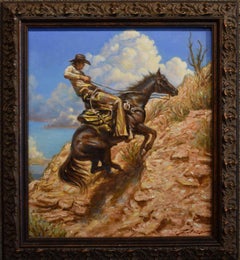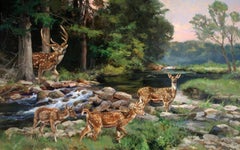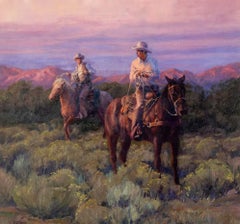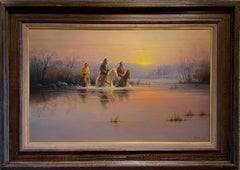Want more images or videos?
Request additional images or videos from the seller
1 of 7
Ed Salazar"LAKOTA SIOUX BRAVE" DEPICTED IN 1840s 60 X 36 CANVAS SIZE 67 x 43 FRAME SIZE!New
New
Price:$19,000
$24,000List Price
About the Item
- Creator:Ed Salazar (American)
- Creation Year:New
- Dimensions:Height: 60 in (152.4 cm)Width: 36 in (91.44 cm)Depth: 3 in (7.62 cm)
- More Editions & Sizes:Image Size: 60 X 36Price: $24,000
- Medium:
- Movement & Style:
- Period:
- Framing:Frame IncludedFraming Options Available
- Condition:
- Gallery Location:San Antonio, TX
- Reference Number:1stDibs: LU769316192242
About the Seller
5.0
Vetted Professional Seller
Every seller passes strict standards for authenticity and reliability
Established in 1974
1stDibs seller since 2017
102 sales on 1stDibs
Typical response time: 1 hour
Authenticity Guarantee
In the unlikely event there’s an issue with an item’s authenticity, contact us within 1 year for a full refund. DetailsMoney-Back Guarantee
If your item is not as described, is damaged in transit, or does not arrive, contact us within 7 days for a full refund. Details24-Hour Cancellation
You have a 24-hour grace period in which to reconsider your purchase, with no questions asked.Vetted Professional Sellers
Our world-class sellers must adhere to strict standards for service and quality, maintaining the integrity of our listings.Price-Match Guarantee
If you find that a seller listed the same item for a lower price elsewhere, we’ll match it.Trusted Global Delivery
Our best-in-class carrier network provides specialized shipping options worldwide, including custom delivery.You May Also Like
Portrait of Italian Greyhound Midfield Role - British sport art dog oil painting
Located in Hagley, England
This lovely dog portrait oil painting is attributed to an artist from the English School. It is an oil on board portrait oil painting and depicts a brown and white Italian greyhound with a black collar called Midfield Role in a landscape. Lower left is a ribbon with the dogs name on it. The accomplished animal artist has perfectly captured the Italian greyhound...
Category
20th Century Realist Animal Paintings
Materials
Oil
$3,732 Sale Price
20% Off
H 29 in W 33 in D 2 in
Horses in a Landscape - Scottish 1960's equine art oil painting female artist
By Doris Zinkeisen
Located in Hagley, England
This superb oil painting of horses is by Scottish female artist Doris Zinkeisen. Painted circa 1960 the composition has six horses in a landscape. There is great impasto and brushwor...
Category
1960s Realist Animal Paintings
Materials
Oil
$3,951 Sale Price
20% Off
H 27 in W 31 in D 2 in
"Cows at Rest in Front of the Barn" Michael Therkildsen (Danish, 1850 - 1925)
By Michael Therkildsen
Located in SANTA FE, NM
"Cows at Rest in Front of the Barn"
Michael Therkildsen (Danish, 1850 - 1925)
Oil on canvas
9 x 14 3/4 (15 3/4 x 21 1/4 frame) inches
Signed lower left
The son of farmer Hans Micha...
Category
Early 20th Century Realist Animal Paintings
Materials
Canvas, Oil
$3,500 Sale Price
20% Off
H 15.75 in W 21.25 in D 1.5 in
Sheep in a Surrey Landscape - British Victorian art sunny landscape oil painting
By George William Mote
Located in Hagley, England
This lovely Surrey landscape oil painting is by noted British exhibited artist George William Mote. Painted circa 1870, the composition is a landscape with a stunning view into the d...
Category
19th Century Realist Landscape Paintings
Materials
Oil
$3,732 Sale Price
20% Off
H 28 in W 38 in D 2 in
Golden Eagle of Scottish Highlands - Scottish art bird landscape oil painting
By Douglas Falconer
Located in Hagley, England
This stunning Scottish oil painting is by noted landscape artist Douglas Falconer. Painted circa 1960 the composition is of a seated golden eagle in a mountainous highland landscape....
Category
1960s Realist Animal Paintings
Materials
Oil
$4,390 Sale Price
20% Off
H 26 in W 30 in D 2 in
Searching for Paradise, Oil Painting
Located in San Francisco, CA
Artist Comments
Two brightly colored macaws soar across a frozen expanse, where towering glaciers rise against a brooding overcast sky. In the foreground, an animal skeleton li...
Category
21st Century and Contemporary Realist Animal Paintings
Materials
Oil
Horses
Located in Zofingen, AG
The most ordinary rural landscape. A quiet life among nature. This place is a good place to relax after the hustle and bustle of the city.
• Includes a certificate of authenticity si...
Category
2010s Realist Landscape Paintings
Materials
Canvas, Oil
Contemporary British Oil Painting Roaring Tiger in Landscape Leaping at Viewer
Located in Cirencester, Gloucestershire
Portrait of an Indian tiger, 2002
Martin Jarvis, British contemporary
signed oil painting on canvas, unframed
dated 2002
canvas: 36 x 29 inches
p...
Category
Early 2000s Realist Animal Paintings
Materials
Oil
$1,097 Sale Price
20% Off
H 36 in W 29 in
Majestic Tiger Tall Grass Realistic Wildlife British Oil Painting Ornate Frame
Located in Cirencester, Gloucestershire
Bengal Tiger
by Mark Chester, British contemporary
Oil on board, framed
Framed: 25.5 x 36 inches
Board: 21 x 31 inches
Provenance: Private collection, UK
Condition: This painting is ...
Category
21st Century and Contemporary Realist Animal Paintings
Materials
Oil
$1,657 Sale Price
20% Off
H 25.5 in W 36 in
'The Belvoir Hunt'
Located in Uppingham, GB
Oil on canvas of the Belvoir Hunt by Tom Carr
Thomas James Carr OBE (21 September 1909 – 17 February 1999) was an Irish artist who was associated with the Euston Road School in the ...
Category
1970s Realist Landscape Paintings
Materials
Oil
More From This Seller
View All"RIDIN' HIGH" COWBOY HORSE WESTERN ACTION MOTION NICE!!!
Located in San Antonio, TX
E. Salazar
Texas Artist
Image Size: 15 x 13
Frame Size: 19 x 17
Medium: Oil on Canvas
"Riding High"
Category
2010s Realist Landscape Paintings
Materials
Oil
"GUADALUPE ROMANCE" WILDLIFE AXIS DEER FAMILY TEXAS RIVER
By Luke Frazier
Located in San Antonio, TX
Luke Frazier
(Born 1970)
Utah Artist
Image Size: 30 x 48
Frame Size: 39 x 57
Medium: Oil
"Guadalupe Romance"
Biography
Luke Frazier (Born 1970)
Luke Frazier grew up hunting and fishing in the mountains of northern Utah. These early forays into nature instilled a kinship with the wildlife, and a passion for the outdoors. As a child he spent hours scribbling, sketching and sculpting wildlife. Later, his formal art training occurred at Utah State University, where he earned a Bachelors of Fine Arts degree in painting and a Masters of Fine Arts degree in illustration.
Every year, Frazier travels through Alaska, Canada, and the American West painting and photographing animals in their environment. His love of fly fishing and hunting is apparent in his work. Influenced by the art of Winslow Homer, Edgar Payne, Bruno Liljefors...
Category
2010s Realist Animal Paintings
Materials
Oil
"Cowboys" GREAT, FUN PIECE. ARIZONA ARTIST SHELIA COTTRELL WESTERN
Located in San Antonio, TX
Sheila Cottrell
(Born 1954)
Arizona Artist
Image Size: 22 x 24
Frame Size: 28 3/4 x 30 1/2
Medium: Oil on Canvas
"Cowboys"
Biography
Sheila Cottrell (Born 1954)
Sheila Cottrell's wes...
Category
Early 2000s Landscape Paintings
Materials
Oil
"FORDING AT DUSK" COWBOYS, HORSEBACK, RIVER CROSSING FRAME 44 X 62 G. Harvey
By G. Harvey
Located in San Antonio, TX
G. Harvey (Gerald Harvey Jones)
(1933-2017)
San Antonio, Austin, and Fredericksburg Artist
Image Size: 30 x 48
Frame Size: 44 x 62
Medium: Oil on Canvas
Dated 1976
"Fording At Dusk"
...
Category
1970s Impressionist Landscape Paintings
Materials
Oil
"A Winter Stop-Over" Western Stagecoach Snow Scene G. Harvey In 1970 Calendar
By G. Harvey
Located in San Antonio, TX
G. Harvey (Gerald Harvey Jones)
(1933-2017)
San Antonio, Austin, and Fredericksburg Artist
Image Size: 24 x 30
Frame Size: 33 x 39
Medium: Oil
Dated 1970
"A Winter Stop-Over" Stageco...
Category
1970s Impressionist Animal Paintings
Materials
Oil
"Gift of Rain" COWBOYS WESTERN SAGUARO CACTUS DESERT SCENE G. Harvey (1933-2017)
By G. Harvey
Located in San Antonio, TX
G. Harvey (Gerald Harvey Jones)
(1933-2017)
San Antonio, Austin, and Fredericksburg Artist
Image Size: 30 x 24
Frame Size: 44 x 38
Medium: Oil on canvas
“ Gift Of Rain “
G. Harvey (G...
Category
1990s Impressionist Animal Paintings
Materials
Oil
Recently Viewed
View AllMore Ways To Browse
Crow Indian
Crazy Horse
General Custer
Oregon Trail
Wonder Horse
The Avengers
William Harvey
Indian And Horse End Of The Trail
Painting California Hills
Painting Switzerland Lake
Paintings Of Portugal
Peruvian Watercolour
Riverscape Landscape
Russo Paint
Scottish Glen
Southwest Pueblo
Unknown Artist Impressionist Painting
1940 California Landscape



